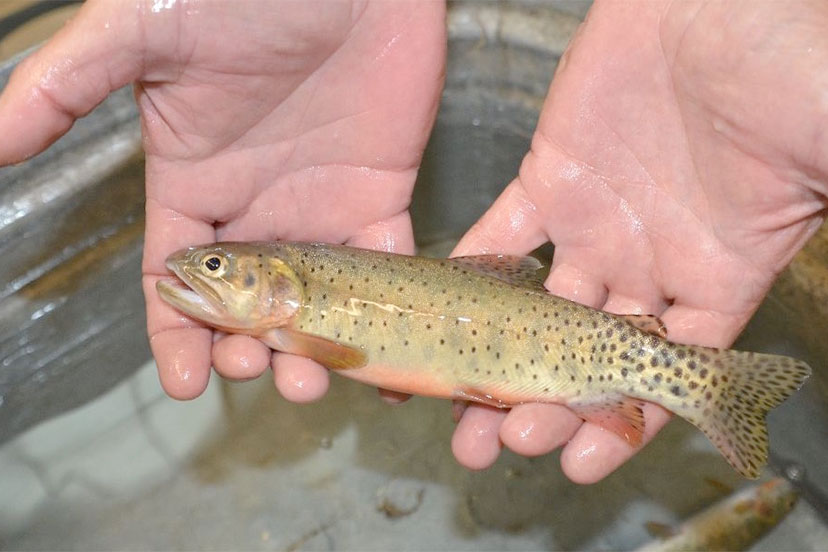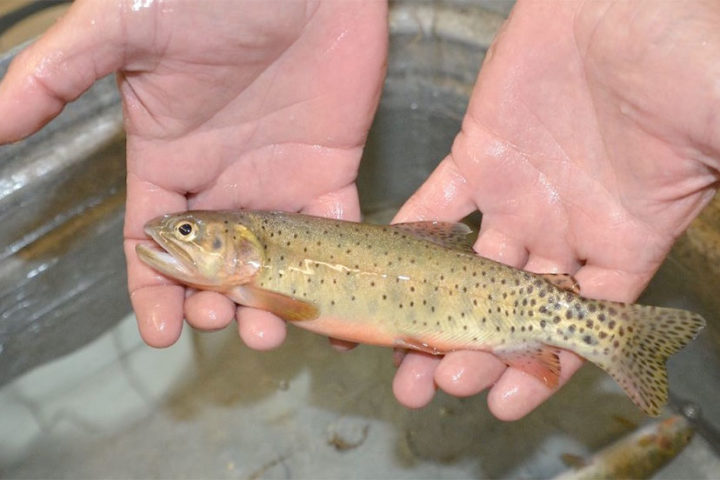The effort by Colorado Parks and Wildlife to restore San Juan Cutthroat Trout in the San Juan River Basin will continue with a key project to remove non-native trout in the headwaters of Wolf Creek in the San Juan National Forest.
CPW crews, with assistance from the San Juan National Forest, will conduct removal efforts of non-native fish the week of August 30. Wolf Creek from the top of the pass to Forest Road 725 (Wolf Creek Road) will be closed to the public for the week while crews conduct the removal operations. The public may access the creek below Forest Road 725 during this time.
This closure is for the creek only and has no impact on traffic on U.S. Highway 160.
The goal of CPW and the San Juan National Forest is to establish a population of recently discovered San Juan Cutthroat Trout in the headwaters of Wolf Creek down to a large 200-foot waterfall a half-mile downstream of Forest Road 39 – known as Fall Creek Road – off U.S. 160. This project is being conducted in three phases.
The first phase was completed in 2018. That project successfully removed non-native trout from the south fork of Wolf Creek located off Forest Road up toward Treasure Mountain.
The second phase is the focus of this year’s efforts and will be conducted in the three-mile section of the headwaters from the top of Wolf Creek Pass down to Forest Road 725.
“Restoring native species is a high priority for Colorado Parks and Wildlife, and Wolf Creek is an ideal location for pure San Juan cutthroat trout,” said Jim White, CPW aquatic biologist in Durango who has coordinated the project.
To establish native cutthroat trout habitat in suitable streams, the removal of non-native trout is essential. Non-native trout compete, prey on and/or readily hybridize with cutthroat trout. Multiple research studies show that San Juan Cutthroat Trout die out in the presence of non-native trout. Successfully establishing a San Juan Cutthroat Trout population requires removing all the non-native trout before San Juan Cutthroat can be stocked.
The removal of non-native fish is done with the use of the EPA-registered piscicide rotenone, an organic chemical that comes from a tropical legume (pea family) root that has been used by indigenous peoples to capture fish and has been used throughout the world for fish management projects. Rotenone only affects gill breathing animals and invertebrates when used properly. CPW, as well as other state fish and game agencies, have successfully used rotenone for more than 80 years to remove fish in controlled and targeted reaches of lakes and streams.
Another chemical — potassium permanganate — is added to neutralize (oxidize) the rotenone at the terminus of the treatment area. The neutralization process takes time, and some incidental fish mortality will occur below the Forest Road 725 waterfall. The creek will be posted with signage during the treatment phase.
CPW has worked on cutthroat trout restoration projects throughout the state for years. Restoration work is done to assure that native trout remain a sustainable and important part of Colorado’s natural environment. Colorado River Cutthroat Trout currently occupy approximately 11% of their historic habitat. Three unique lineages of Colorado River Cutthroat Trout were identified in 2012. One of those, the San Juan Cutthroat, was previously thought to be extinct.
Knowing what to look for, CPW researchers discovered six small populations of these fish in 2018. After years of hard work to spawn this lineage at the Durango Fish Hatchery, CPW and the San Juan National Forest are currently working to expand those populations into headwater streams such as Wolf Creek where the water is pristine and free of whirling disease. Pure native cutthroat trout are not stocked in major rivers because they cannot compete with established rainbow and brown trout populations.
The treated areas will be void of fish until next summer. After the spring runoff in 2022, CPW biologists will check the streams to assure non-native trout have been eliminated; if none are found, San Juan Cutthroats will be stocked next summer.
“Restoration of native cutthroat trout is a priority for Colorado Parks and Wildlife, and this is a key project for the San Juan cutthroat trout recovery program,” said John Alves, senior aquatic biologist for CPW.
To learn more about CPW’s work to restore native cutthroat trout throughout the state, go to: https://cpw.state.co.us/learn/Pages/ResearchCutthroatTrout.aspx
For more information about this project, contact CPW Aquatic Biologist Jim White at 970-375-6712 or San Juan National Forest Fisheries Biologist Clay Kampf at 970-884-1403.


